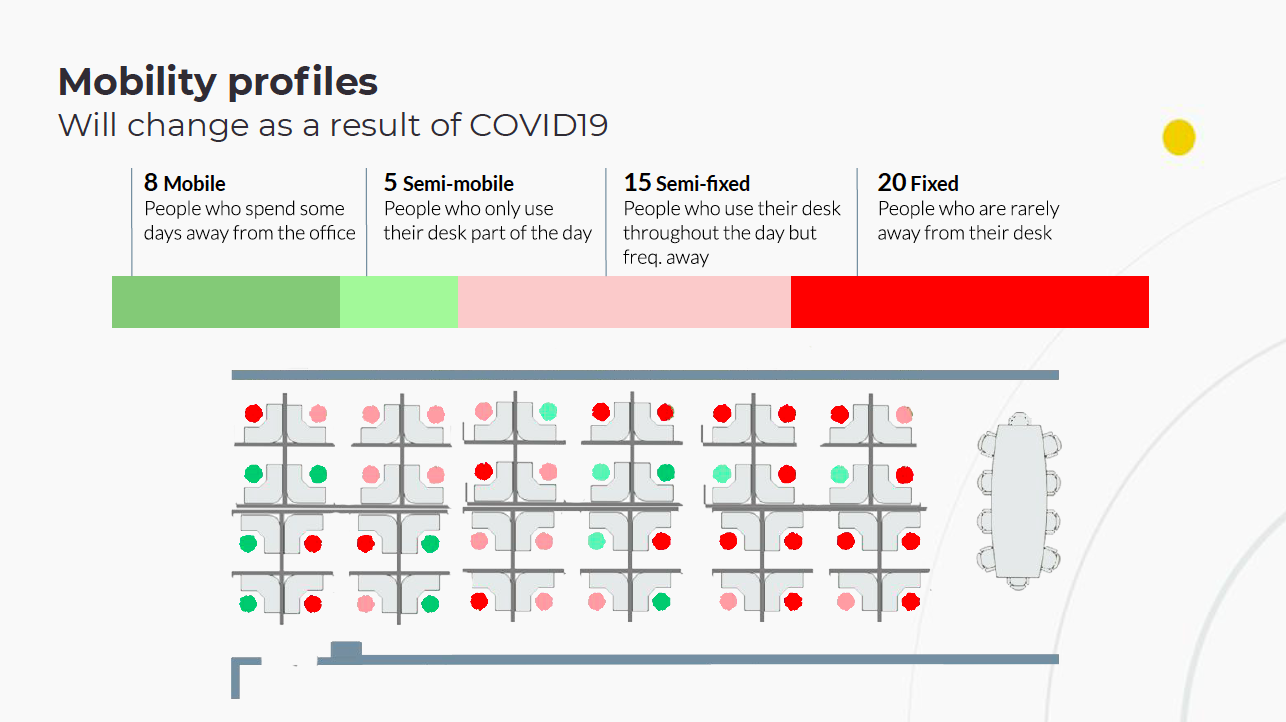Take a look at the importance of leveraging data in your workplace policy, and explore its role in successfully implementing and managing hybrid work environments.
Why workplace policy matters
Traditional 1:1 office environments are a thing of the past, as the COVID19 pandemic and ensuing lockdown orders uprooted our working lives and forced organisations to move into a fully remote, digital world. Now, hybrid environments are emerging as the workplace model of the future.
These hybrid models serve to facilitate all and every workstyle, enabling employees to decide for themselves how and where they want to work. Workplaces inevitably will need to adapt, becoming highly dynamic as employees engage far more critically with office spaces.
Clearly, new systems and tools are required to manage this, from
occupancy solutions to ensure that the office itself is fit for purpose and remains at a safe capacity level, to
booking systems which enable employees to access the spaces they require.
However, as Lucy Fox and Louis Lhoest discussed in a recent webinar session, technology alone is not enough to manage these hybrid frameworks.
The success of hybrid work hinges on the ability of employees to be able to easily and quickly access the spaces they require, meaning that offices need to be providing the correct array of workplace assets, and ensure that they are used to their full potential.
Booked spaces which go unused within hybrid environments not only represent a sunken-cost, but also a missed opportunity for another employee to access the workplace, and therefore potential delays to projects and overall frustration with the organisation as a whole.
Therefore, it is the role of workplace policy to ensure that these systems and tools are being used correctly.
The importance of data in policy planning
Under traditional office setups, space allocation and usage was a relatively straightforward process, with few organisations adopting Activity Based Working (ABW) models but the majority of businesses providing 1:1 assigned seating.
Under hybrid models, with employees choosing to work remotely for a significant portion of the week, space becomes a far more concerning commodity.
Organisations have to find the sweet spot between providing adequate spaces, but avoiding large swaths of the office going unused. As such, policy surrounding space allocation and usage needs to be centred around employee behaviour, and this is impossible to do without gathering workplace data. Below a few key areas in which evidence based policy is vital are examined.
Allocating and accessing space
Successful hybrid environments promote the ability of employees to work as and when they choose, meaning space allocation needs to be a top priority for HR and FM teams.
In office environments in which employees outnumber the spaces available, systems need to be introduced which ensure that maximum capacity is not exceeded.
Booking systems are vital to this process, but alone are not enough.
In order to stop employees attempting en masse to access the office at the same time organisations need to create role based mobility profiles, which can be used to forecast and predict departmental usage of space, and in turn allocate specific spaces and time periods in which employees are able to access the workplace.
The creation of these mobility profiles is impossible without leveraging
workplace data, which enables teams to understand how departments and varying roles are interacting with the workplace.
Introducing policies such as these is a vital part of ensuring that office usage remains stable throughout the week, as demands on space are understood and managed.
Overcoming obstacles
Even before COVID19, there were frustrations felt both by individual employees and the teams responsible for space management. Block bookings of meeting rooms caused delays to projects, and frustration as they were seen to go unused.
The impact of these obstacles is magnified in hybrid environments, as space itself is a more valuable and sought after resource. As such, ensuring that every measure possible is taken to ensure that the systems which exist to allocate and access space are not misused is highly important.
Gathering
booking data enables HR and Facilities teams to have meaningful conversations with department heads when issues are identified, and the resulting policies target specific problems instead of restricting employee behaviour as a whole. Speaking recently, Louis Lhoest highly stressed the importance of ensuring that policies are designed to enable employees, not restrict them, and without data this is impossible.
Safeguarding employee wellbeing during COVID19
The #1 priority for all HR and Facilities teams as offices reopen throughout 2021 has to be the health and safety of employees. Social distancing measures must be in place and enforced, and measures need to be introduced to ensure that the
Indoor Air Quality (IAQ) within corporate spaces remains at a safe level.
Already as offices reopen the ineffectiveness of physical reminders and email communications regarding social distancing is becoming evident, as employees fall back into old habits and congregate around workstations. Workplace data can be used by HR and Facilities teams to highlight these issues, and address them at their root cause.
Similarly, ensuring that IAQ remains at a safe level is inextricably linked to capacity control. Leveraging
environmental data in conjunction with occupancy data provides insights into the relationship between capacity and IAQ, enabling HR and Facilities teams to fine tune their policies regarding space allocation and access.
Key takeaways
-
Evidence based policy and technology are both necessary to create and manage hybrid environments in the long term
-
Data is key to space management in hybrid environments, as it is a highly valuable resource which cannot organisations cannot afford to misuse
-
Workplace data unlocks smart solutions to problems which were previously largely guesswork
-
Safeguard employee wellbeing with data by ensuring that your offices IAQ remains at a safe level by better managing capacity
Watch the video


